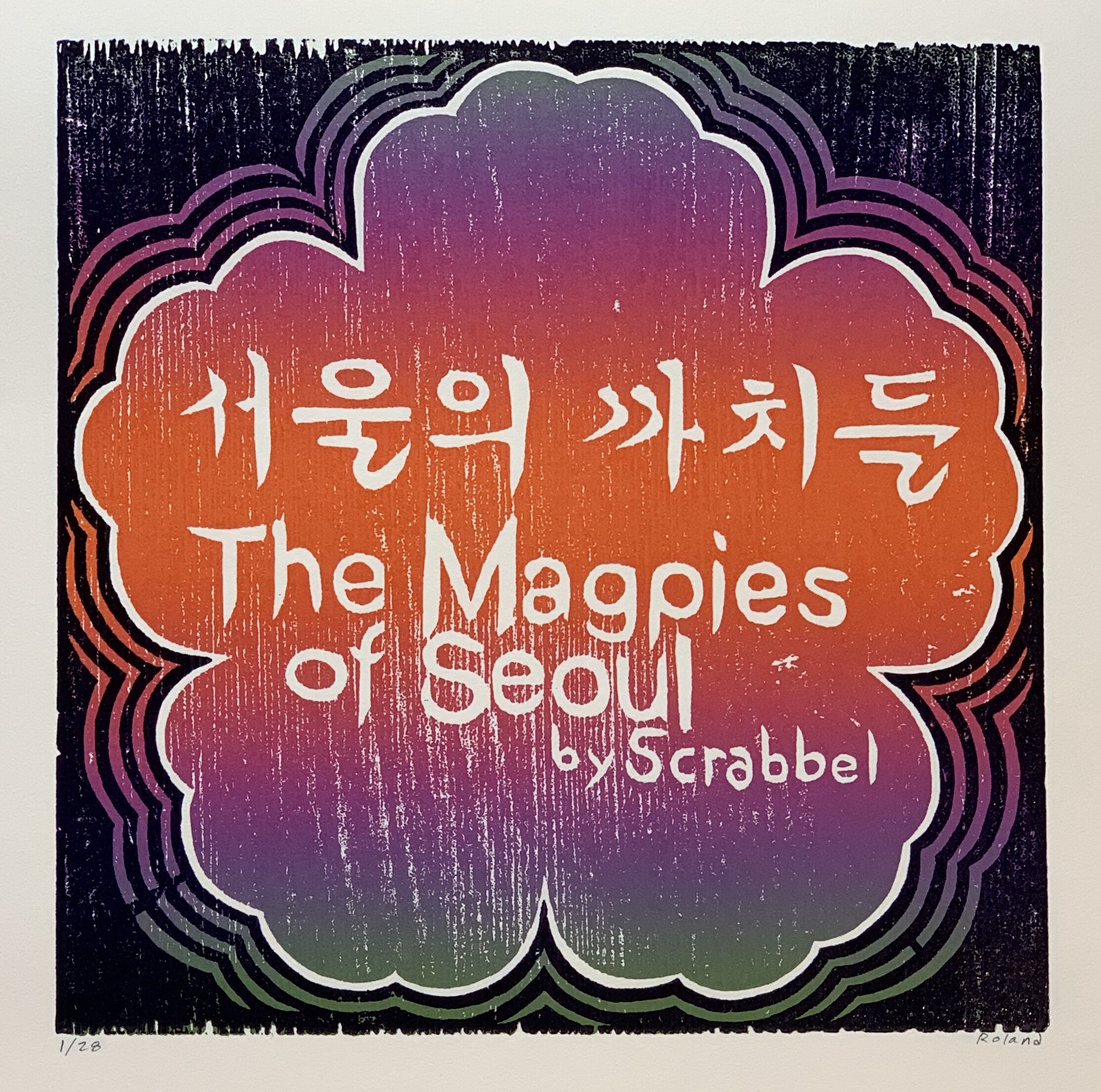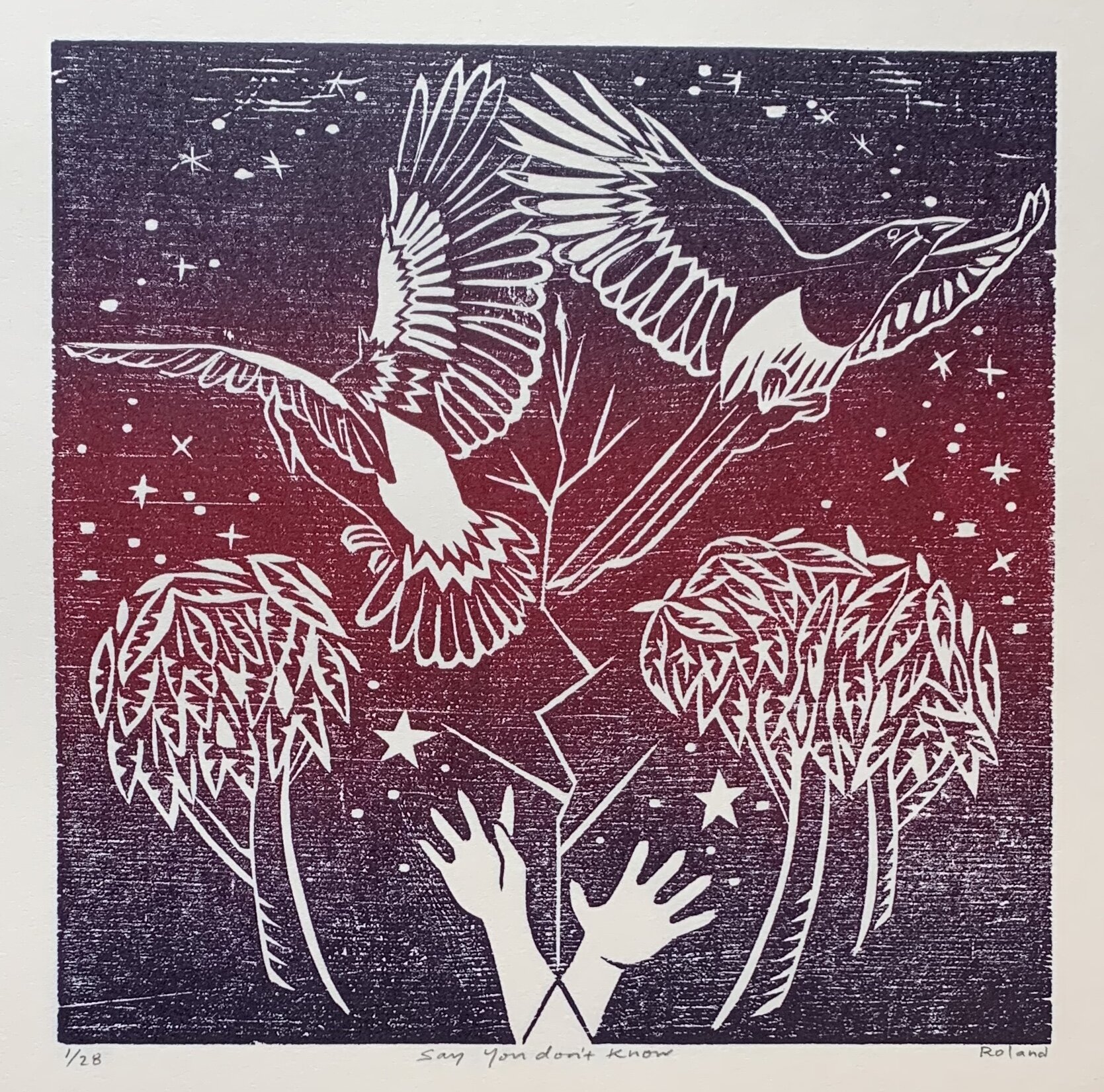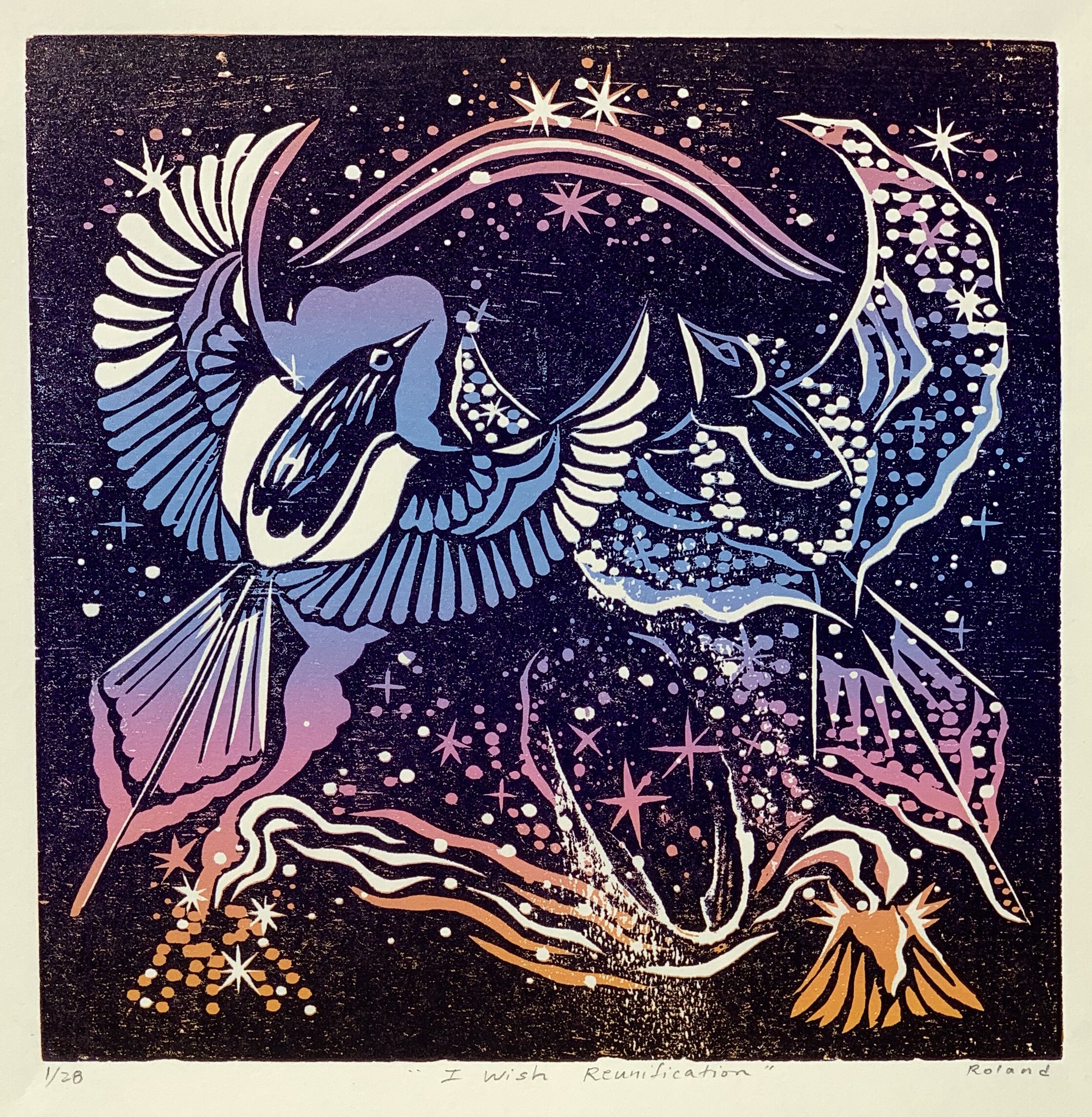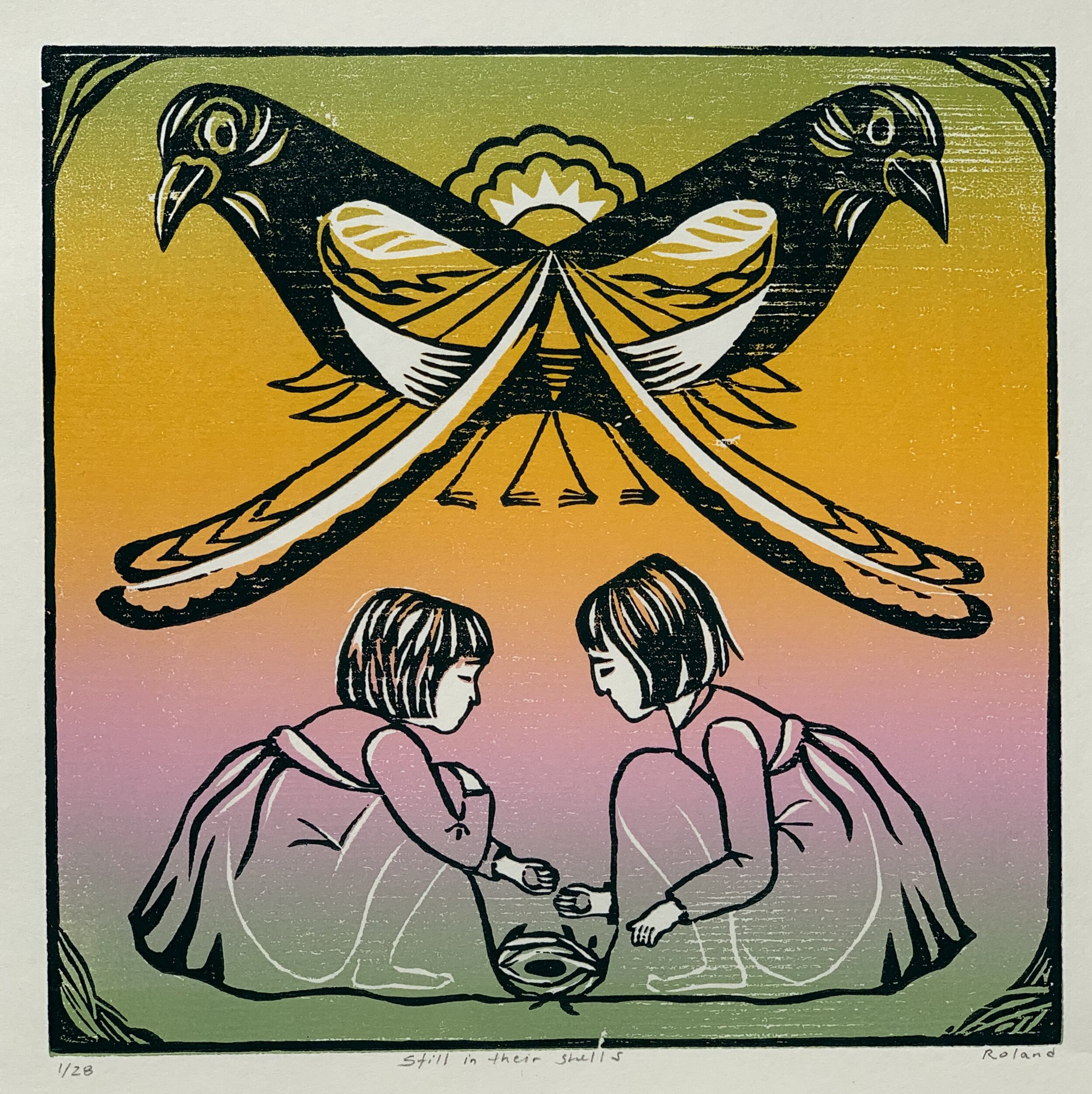Dan Lee: Magpies Of Seoul
About a year ago, Dan Lee of Scrabbel embarked on an ambitious creative project called “Magpies of Seoul”. (See trailer above). Dan enlisted a large group of musicians and artists to help him tell his version of Chilseok, a Korean Folktale, in which he interlaced historical references to the Korean War.
The project featured Art by Rochelle Youk, Hellen Jo, Joseph To and Nathalie Roland. Dan wrote to 8 songs which were performed live by 9 musicians in front of a large screen movie projection movie featuring all the Art works on May 12th, 2019 at the Kabuki Theatre in San Francisco as part of the CAAM fest. The Art and Music was also collected into a storybook and CD.
Almost a year after the live performance of Dan Lee’s project “The Magpies of Seoul”, we catch up about the creative journey he took to bring it all together. From the first spark to the live performance at the Kabuki Theatre, we hope to bring you into his creative process. How did his idea first begin and transform into the resulting collection of songs, images and performance. Read on to find out!
Dan Lee of Scrabbel in the Richmond. Photo by Nathalie Roland.
At what point would you say the seed for this project was planted? I think that I’m always trying to explore my Korean roots in some way or another, but I didn’t have this particular story idea until I started writing the grant proposal. In some ways it was very last minute, but I think it was always in me and I just needed the pressure of a deadline to bring it out. Blending musical traditions was always a desire. The story to base it around came from my wedding date and the folktale associated with it (Chilseok), as well as my family history. I’ve always had a fascination with the DMZ and North Korea, so the idea of doing my own take on that folktale seemed very obvious to me. Trump and his border wall and the separation of those families also fueled the idea of writing something about 2 people being separated by the Korean War and finding a way to be reunited.
What activated you to begin the work? I was actually on vacation in Japan when I was notified I would get the grant. It was very exciting and frightening at the same time. Suddenly the idea was very real. I had never applied for a grant (sort of). I had thrown so much into the application to beef it up and now I was suddenly being committed to follow through!
Still from “Little Bird Finds Her Sister” in “Magpies of Seoul” performance video by Dan Lee.
What were your first steps? My first step was to re-read my grant proposal!!! Ha ha! In my defense though, there is a 6-7 month gap between turning it in and then hearing about any decisions. My daughter was 3 at the time, and I was about to change jobs, so I had more immediate things going on. After that, I made an outline of my story and how I wanted to write songs for the key moments in it. Then I did a mad scramble to find korean drummers to collaborate with. I reached out to a drummer friend (James Kim) and he pointed me in the direction of Dohee Lee. She became a crucial collaborator for my project: supplying drumming, singing, and knowledge of korean culture that shaped the story. Connecting with UC Berkeley’s EGO (korean drumming group) was the last piece to the musical puzzle.
What questions were you trying to answer for yourself through the project? The biggest thing for me was finding out whether I could make music blending traditional Korean drumming with my western music sensibilities. Could I make something that I was proud of and excited about? I like to challenge myself musically. I didn’t know if I could make music with instruments and traditions I am unfamiliar with. In my head there was a musical spectrum where I would write songs based on korean drumming, write songs and add korean drumming, and all of the in between. I was very conscious of exploring those avenues and not just forcing korean drums into what I normally do.
What were some decisions you had to make a long the way? Maybe the toughest decision was that I didn’t have the time to fix certain mistakes, so I have to just accept that they are on the final recordings. Also, we had to do the live performance without Dohee and with less korean drummers because of scheduling conflicts. Rather than keep searching for a date, I chose to perform at CAAMfest because I felt like it would reach a wider audience. It was a sold out show, so that was a good decision!
On the art side, I waffled between working with multiple people or with just one artist. The pros for 1 artist is that the final look would have been consistent (and also 3 less people to manage/schedule etc). The cons for 1 artist would have been more work for that person, which didn’t seem possible when I asked, given the time constraints. I ultimately chose to divide up the workload. That, theoretically, gave them more time to work on their stuff, so it was great for quality over quantity. Having different artists also added to the diversity in styles and ideas, which also broadened the audience.
JuYeon on the left, Monica on right playing the janggu- for “little bird finds her sister “ Photo by Dan Lee.
What were some of the problems you had to solve? When recording Warren playing a western drum kit over a traditional korean drumming piece (North Invades The South) there were issues with the timing and tempo. Korean drumming is more free and guided by the lead drum (kkwaengwari played by Ju Yeon) so it can speed up and slow down, which made it difficult to follow. I also hadn’t worked out all the music for the song so I believe Warren had only the korean drums and a bass line to work from. We recorded it in segments and I had to explain what I wanted in each section. It’s like acting with a green screen. In some ways he was playing blindfolded, and so was I. As a result, there was some post-production magic that I used to line up his drums at certain moments, but the end result is fantastic. The two songs he plays on are my favorites because they really capture what is possible when combining different styles.
What were some of the tools you used to make it all happen? I recorded it all myself- mostly in my apartment, except the loud drum ensembles (in my parent’s living room) and Warren (in his practice space). It was mixed and mastered in San Antonio with Chris Cline in his house. - all on a computer. The artists used their arty tools, and I just peeked in at different stages when I could. The video projections were shot on my phone and made in iMovie.
What was happening during the process in the background? A 3 year old, a wife, a 40hr/week job, and not much sleep.
What influenced the project? The old photo of my mom and her friend inspired the basic story idea, as well as my family history during the Korean War. There were so many things that happened during the process that added, altered, and advanced the project: buying a kalimba inspired the opening track, seeing an old video on YouTube of Dohee inspired a song (Reunification, I Wish) and led to me recruiting her, and researching the Korean War led to adding sound FX and voiceover samples on the centerpiece song (The North Invades The South)
What role did San Francisco play? A direct result would be that the cover of the book (as well as the artwork for Little Bird Finds Her Sister) was a photo taken on the cliffs near Baker Beach overlooking the Pacific Ocean. Some footage used in the video projections were also shot at various SF locations (Sutro baths, Baker Beach, etc)
What was it like to work with so many people on one thing? It was really great to have different ideas brought in that I would never have thought of on my own. For instance- having the climax of the story happen on the two mountains (Hallasan and Paektusan) was Dohee’s idea. Her knowledge of Korea placed my ideas into a physical space that really solidified the story. Subtle details like having the title art piece be outlined by the shape of a hibiscus flower (korean national flower) was my friend’s idea (Julia Kim). I dabble in a lot of instruments, but I could never do the drumming that Warren added to the songs he played on (North Invades The South and Little Bird Finds Her Sister). I also couldn’t do the type of art that the visual artists made for the project.
On the other side, it was also a logistical nightmare to have so many people involved. Scheduling rehearsals, finding a performance date that everyone could do, and trying to coordinate and track everyone’s work to make sure they meet their deadlines.....that was the painful side.
How many people were involved? From UC Berkeley - 6 drummers recorded with me, 4 played the live show. 4 others (myself included) recorded songs (me, Aya, Sadie, and Warren). Mom did voiceover work. Ami did voiceover and video work. Lucia was also in one of the videos. Chris Cline helped mix and master. Han played the live show with us. Pauline did the book layout. Myleen helped with the book cover layout. Nathalie, Helen, Rouchelle, and Joe were the visual artists. Beatrice (and her team) helped me write the grant. The live show had the sound guys and stage managers, and festival staff (I don’t know those numbers).
What did you learn about collaboration? I think that it works well and sometimes it’s difficult. The end result was very satisfying and beautiful, but maybe it was a rough process at times- depending on the collaborator and the particular situation....and who you ask!
I’m not sure how they might feel. I tried to be open and free about letting others do and create how they create, yet I had to find that balance between guiding them to my project goals/vision as well. Everyone is different: some folks wanted to be told what I wanted and others didn’t, and sometimes their work altered where I thought I was going, so I had to switch up my side because of what they did to take the project in a different direction...etc.
What kind of support did you get for the project? I got grant money from SF Arts Commission. That made it all possible and I got a lot of quality work from the people involved. For me, it was a labor of love, but I don’t know what it was for the others.
What were things that happened in order to finish it? Who was essential in bringing the whole thing to the finish line? Everyone. But if we are talking specifically about the finish line, then Pauline Choi and Joe To were the last ones to carry the baton. Pauline helped me layout the book (which was a last minute addition in itself) and Joe helped with that, plus he was a last minute artist who came up with the piece for “Magpies in the Sky”.
How did you know when it was finished? There were 3 moments - in this order: I flew to San Antonio for a long weekend to mix the music. When I left, it was done (except for the mastering). On the other side, when I sent the pdf to the printers, then I knew it was out of my hands. And then when we played the final note and the house lights came up. Those were the 3 exhale moments for me.
What will you take away from the experience? It started as a small musical idea and grew into a very large project. It became incredibly personal to me because of the story and involvement of my mom, and daughter, and wife. It’s a time capsule for my family.
Do you have any visual relics of the process, like notes or sketches or random visual mementos of the experience? Tons. The videos that accompanied the songs at the live performance are their own little documentaries for how the art was made, songs were recorded, and what I could convince my daughter to do to “act out” some of the narrative.
What would you like to see in the future for this project? I wish we could do it live at least once more. It’s a shame to have put so much work into something and only perform it once. As a story, I think it could be expanded into something very unique. I’m not sure I’m the one to do that though. That’s another collaboration...
About the Magpies woodcuts…. Following prompts from Dan, I created four woodcut prints, one to illustrate each of the four songs I was assigned. The prompts were varied combinations of written story, parts of or completed songs and sometimes reference photos. For in-depth process documentation, please check out my Magpies IG Highlight. Swipe through below to see all four finished woodcut prints.










